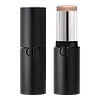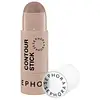What's inside
What's inside
 Key Ingredients
Key Ingredients

 Benefits
Benefits

 Concerns
Concerns

 Ingredients Side-by-side
Ingredients Side-by-side

C15-19 Alkane
SolventCaprylic/Capric Triglyceride
MaskingMica
Cosmetic ColorantHelianthus Annuus Seed Wax
Skin ConditioningSaccharomyces Ferment
Skin ConditioningCoco-Caprylate/Caprate
EmollientSilica
AbrasivePhytosteryl/Octyldodecyl Lauroyl Glutamate
Skin ConditioningPolyglyceryl-2 Triisostearate
EmulsifyingIris Florentina Root Extract
MaskingAluminum Hydroxide
EmollientParfum
MaskingBrassica Campestris Seed Oil
Skin ConditioningEuphorbia Cerifera Wax
Copernicia Cerifera Wax
Lauroyl Lysine
Skin ConditioningDisteardimonium Hectorite
StabilisingOpuntia Ficus-Indica Flower Extract
Skin ConditioningCamelina Sativa Seed Oil
Skin ConditioningPentaerythrityl Tetra-Di-T-Butyl Hydroxyhydrocinnamate
AntioxidantWater
Skin ConditioningTocopherol
AntioxidantSodium Benzoate
MaskingPotassium Sorbate
PreservativeCI 77891
Cosmetic ColorantCI 77491
Cosmetic ColorantCI 77492
Cosmetic ColorantCI 77499
Cosmetic ColorantC15-19 Alkane, Caprylic/Capric Triglyceride, Mica, Helianthus Annuus Seed Wax, Saccharomyces Ferment, Coco-Caprylate/Caprate, Silica, Phytosteryl/Octyldodecyl Lauroyl Glutamate, Polyglyceryl-2 Triisostearate, Iris Florentina Root Extract, Aluminum Hydroxide, Parfum, Brassica Campestris Seed Oil, Euphorbia Cerifera Wax, Copernicia Cerifera Wax, Lauroyl Lysine, Disteardimonium Hectorite, Opuntia Ficus-Indica Flower Extract, Camelina Sativa Seed Oil, Pentaerythrityl Tetra-Di-T-Butyl Hydroxyhydrocinnamate, Water, Tocopherol, Sodium Benzoate, Potassium Sorbate, CI 77891, CI 77491, CI 77492, CI 77499
Caprylic/Capric Triglyceride
MaskingIsostearyl Isostearate
EmollientOctyldodecanol
EmollientAluminum Starch Octenylsuccinate
AbsorbentLauroyl Lysine
Skin ConditioningCI 77891
Cosmetic ColorantDimethicone
EmollientDicalcium Phosphate
AbrasiveEuphorbia Cerifera Wax
Copernicia Cerifera Wax
Dimethicone/Vinyl Dimethicone Crosspolymer
Skin ConditioningCI 77499
Cosmetic ColorantOryza Sativa Bran Wax
Skin ConditioningSynthetic Beeswax
Emulsion StabilisingCI 77492
Cosmetic ColorantDisteardimonium Hectorite
StabilisingCI 77491
Cosmetic ColorantHelianthus Annuus Seed Wax
Skin ConditioningSynthetic Wax
AbrasiveTocopherol
AntioxidantPropylene Carbonate
SolventHelianthus Annuus Seed Oil
EmollientChlorella Vulgaris Extract
Skin ConditioningRosmarinus Officinalis Leaf Extract
AntimicrobialCaprylic/Capric Triglyceride, Isostearyl Isostearate, Octyldodecanol, Aluminum Starch Octenylsuccinate, Lauroyl Lysine, CI 77891, Dimethicone, Dicalcium Phosphate, Euphorbia Cerifera Wax, Copernicia Cerifera Wax, Dimethicone/Vinyl Dimethicone Crosspolymer, CI 77499, Oryza Sativa Bran Wax, Synthetic Beeswax, CI 77492, Disteardimonium Hectorite, CI 77491, Helianthus Annuus Seed Wax, Synthetic Wax, Tocopherol, Propylene Carbonate, Helianthus Annuus Seed Oil, Chlorella Vulgaris Extract, Rosmarinus Officinalis Leaf Extract
 Reviews
Reviews

Ingredients Explained
These ingredients are found in both products.
Ingredients higher up in an ingredient list are typically present in a larger amount.
This ingredient is an emollient, solvent, and texture enhancer. It is considered a skin-softener by helping the skin prevent moisture loss.
It helps thicken a product's formula and makes it easier to spread by dissolving clumping compounds.
Caprylic Triglyceride is made by combining glycerin with coconut oil, forming a clear liquid.
While there is an assumption Caprylic Triglyceride can clog pores due to it being derived from coconut oil, there is no research supporting this.
Learn more about Caprylic/Capric TriglycerideCi 77491 is also hydrated iron III oxide. It's sole purpose is to give a red/pink hue to products.
Iron III oxides are classified as inorganic chemicals for coloring.
Synthetically created Ci 77491 is considered safer than those naturally found. This is because the synthetically created version may contain less impurities. Iron oxides are generally non-toxic and non-allergenic.
Learn more about CI 77491Ci 77492 is also hydrated iron III oxide. It's sole purpose is to give a yellow hue to products.
Iron III oxides are classified as inorganic chemicals for coloring.
Synthetically created Ci 77492 is considered safer than those naturally found. This is because the synthetically created version may contain less impurities. Iron oxides are generally non-toxic and non-allergenic.
Learn more about CI 77492Ci 77499 is also hydrated iron III oxide. It is created from mixing red and black iron oxides. This helps give shades of darkness to a product.
Iron III oxides are classified as inorganic chemicals for coloring.
Ci 77891 is a white pigment from Titanium dioxide. It is naturally found in minerals such as rutile and ilmenite.
It's main function is to add a white color to cosmetics. It can also be mixed with other colors to create different shades.
Ci 77891 is commonly found in sunscreens due to its ability to block UV rays.
Learn more about CI 77891Copernicia Cerifera Wax comes from a palm tree native to Brazil; another name for this ingredient is Carnauba Wax.
This ingredient is used to thicken texture and also leaves behind a film when applied.
Fun fact: This wax has the highest melting point of all natural waxes and low solubility.
Learn more about Copernicia Cerifera WaxDisteardimonium Hectorite comes from the clay mineral named hectorite. It is used to add thickness to a product.
It can also help stabilize a product by helping to disperse other ingredients.
Hectorite is a rare, white clay mineral.
Learn more about Disteardimonium HectoriteHelianthus Annuus Seed Wax is created from the common sunflower.
Sunflower seed wax is made up of long chain non-glyceride esters, a small amount of fatty alcohols, and fatty acids.
This ingredient is often used to enhance the texture of products. The fatty acid properties also help hydrate the skin.
Learn more about Helianthus Annuus Seed WaxThis ingredient comes from a fatty acid (lauric acid) and amino acid (lysine). It is used to add a silky feel to cosmetics.
According to a manufacturer, its fatty acid base leaves a silky feeling on the skin. It also has emollient properties because of this. Emollients help soften skin by preventing water from evaporating.
Lauroyl lysine is barely soluble in water.
Learn more about Lauroyl LysineTocopherol (also known as Vitamin E) is a common antioxidant used to help protect the skin from free-radicals and strengthen the skin barrier. It's also fat soluble - this means our skin is great at absorbing it.
Vitamin E also helps keep your natural skin lipids healthy. Your lipid skin barrier naturally consists of lipids, ceramides, and fatty acids. Vitamin E offers extra protection for your skin’s lipid barrier, keeping your skin healthy and nourished.
Another benefit is a bit of UV protection. Vitamin E helps reduce the damage caused by UVB rays. (It should not replace your sunscreen). Combining it with Vitamin C can decrease sunburned cells and hyperpigmentation after UV exposure.
You might have noticed Vitamin E + C often paired together. This is because it is great at stabilizing Vitamin C. Using the two together helps increase the effectiveness of both ingredients.
There are often claims that Vitamin E can reduce/prevent scarring, but these claims haven't been confirmed by scientific research.
Learn more about TocopherolEuphorbia Cerifera wax comes from a shrub in Northern Mexico. It is used to stabilize formulations and has emollient properties.
Emollients form a thin layer on top of skin to prevent water from evaporating, keeping skin and lips hydrated.
According to a manufacturer, this wax can range from a yellow/brown color to translucent.
Learn more about Euphorbia Cerifera Wax